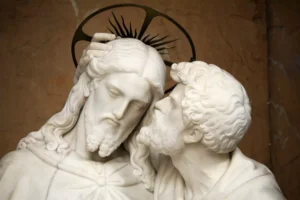When people think about Valladolid, Spain, the phrase “cutting edge” usually doesn’t come to mind. On the contrary, Valladolid is a place that practically screams “tradition” if not “old.” Its Romanesque towers remind us that by the time Ferdinand and Isabella were married there in 1469, the city was already more than 400 years old. Its university — which if you will permit a personal note, counts members of my family among its graduates — was founded around the same time as Oxford. And the city’s most famous resident, Miguel Cervantes, the author of Don Quixote, died in 1615. (On the same day as William Shakespeare, no less.)
It’s been a while since anyone looked to the ancient capital of Castile and Leon for a glimpse of the future. But that’s what happening now and as it turns out, for the same reasons that bedevil the thoroughly modern USA.
Earlier this year, the Spanish parliament passed a law that granted homosexual couples the same marital rights as heterosexual ones. The legislation, scheduled to take effect within the next few months, was called “profoundly iniquitous” by the Vatican, a move that not so long ago would have carried great weight in this traditionally Catholic country. But as the saying goes, that was then and this is now, and now the Socialist government of Jose Luis Rodriguez Zapatero insists that everyone must comply with the bill.
Valladolid’s mayor, Javier Leon de la Riva, begs to differ. He told the press, “even if the law allows me to marry homosexuals, I will not exercise this authority, nor will I delegate the authority to a subordinate.” He added, “I do not have a problem with these couples having the same rights as the rest of the citizens. But what does not seem right is that their union should be called a marriage.”
As you are no doubt aware, the conflict over same-sex marriage isn’t limited to Spain. Just last week, a federal court overturned a voter-approved constitutional amendment that read “only marriage between a man and a woman shall be valid or recognized in Nebraska.” While it’s tempting to see the drive toward recognizing same-sex marriage as something that is being imposed on us by arrogant political and legal elites, succumbing to that temptation would miss the underlying cultural shift that gives this drive much of its cultural traction.
The late David Orgon Coolidge, who headed the Marriage Law Project at Catholic University’s Columbus School of Law, described what he called the “contending models of marriage.” By “model,” Coolidge meant a “claim about what marriage ‘really’ is.” The “traditional model … views marriage as [an] institution.” While this model understands and honors the role that love and affection — what Coolidge called the “interpersonal dimension” — plays in the decision to get married, the “traditional” model nevertheless insists that this love and affection are lived out within an institution whose essence and purpose transcends the desires and intentions of the people getting married.
This essence and purpose is rooted in what Coolidge called “sexual complementarity — the reality that men and women are ‘different from, yet designed for’ one another.” This complementarity is expressed in the procreation and nurture of children but is not exhausted by these “particular functions.” In other words, while having and raising children helps to order and make sense of marriage, there’s more to marriage than the kids. Sexual complementarity results in a bonding between two people wherein “one plus one adds up to more than two.”
The other “contending models” root marriage in something other than sexual complementarity. And unlike the communal dimension inherent in the “Traditional” model,” they see marriage in more private and even individualistic terms. The “Choice” or “Liberal” model defines marriage as “essentially an agreement” between “sovereign selves.” While the agreement between the parties “may take an institutional form,” the marriage itself is a “contractual reality … defined and created by the individuals who enter into the contract.” And, as with all contracts, the purposes of the marriage grow out of the desires of the contracting parties: in most cases, an increase in their personal happiness.
The third model, the “Postmodern” one, while also rejecting sexual complementarity as the basis for marriage, rejects the off-putting idea of marriage as an agreement for the more palatable one of marriage as a “relationship.” Just as with the “Liberal” model, the relationship “can be institutionalized,” but in this model, what holds a marriage together isn’t a set of a priori beliefs about the nature of marriage; rather, it’s the obligations that grow out of being in a relationship with someone and, as Georgetown Law professor Milton Regan put it, the “web of interdependence” that is created by this interaction with another person.
Apart from some churches, it’s difficult to name a part of Western society where the “Traditional” view of marriage still holds sway. Certainly not in marriage and family law where the “Liberal” model is virtually unchallenged. “No-fault” divorce laws are the near-perfect embodiment of the idea of marriage as an agreement or contract. When one “sovereign self” decides that happiness lies outside the marriage, they are free to leave, subject to a satisfactory division of marital property. The only acknowledgment that someone besides the couple has a stake in what is happening are child-support laws. Even there, it’s not clear who the “someone” is: the child or the taxpayer who might be forced to support the child in the absence of parental support.
The situation outside the courthouse is scarcely better. If you surveyed a representative sample of Americans and other residents of the industrialized world, you would almost certainly find their understanding of marriage is closer to the “Liberal,” and, especially, the “Postmodern” models than to the “Traditional” one. The answer to the question “why do people get married?” would seem so obvious to them — “because they love each other” — that they might think it’s a trick question. For most people, marriage is an expression of the shared affection between two people. It is a public celebration of an already-existing relationship between the two.
You see this belief in the increased popularity of writing one’s own vows and in celebrating the wedding in nontraditional places, especially places that figure prominently in what Regan calls the couple’s “shared history.” But even when people get married in a traditional setting, the decision is rooted more in aesthetics than in our beliefs about marriage. White gowns and church weddings are garnish, not the meal. For most people in the West, the public, as distinct from communal, dimension of marriage lies in the financial and legal benefits associated with marriage and the desire for others to celebrate and affirm the relationship.
Which brings us back to Valladolid and Nebraska. If you replace sexual complementarity, procreation and the nurture of children with “mutual obligations” and “interdependence” as the basis for marriage, extending marital rights to same-sex couples isn’t much of a conceptual leap. The argument that denying same-sex couples the right to marry deprives these couples “of [the] public means to express their intimate commitment,” not to mention certain legal and financial benefits, resonates not only with judges and lawyers but also with many Americans, even those who aren’t prepared to support same sex marriage.
This is what I mean by “cultural traction.” While a large majority of Americans are opposed to legalizing same-sex marriage, for the most part this opposition doesn’t grow out of their convictions, explicit or implicit, about the nature and purpose of marriage. Instead, it’s the product of a moral intuition that this is a line that should not be crossed.
While this is a laudable intuition, its long-term viability is doubtful. If polling data are to be believed, younger Americans are more likely to favor legal recognition of same-sex marriage than Americans as a whole. I think this trend can be reversed but only if we go beyond saying that “marriage is the union of one man and one woman” to explaining why that’s the case and more importantly, living as if we believed it. Without these next steps, the effort to limit legal marriage to one man and one woman might prove to be, well, Quixotic.
Copyright 2005 Roberto Rivera y Carlo. All rights reserved.










